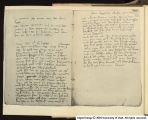| OCR Text |
Show 22 PAPERMAKIN first English patent peraining to moulds for papermaking. Th d making of moulds used by papermakers, and for the mor correct and espeditous method of working and binding wire fo sieves, sereens, etc While there are no rules for distinguishing the p'\pcr of one century or country from another, i is possible by makin a study o the texture and fibre of the paper and of th and the character of their impressions,to arrive at the approximat date and determine in what country and under what condition the paper was made. With wove paper it is not casy to attach date to the sheets, but paper of this type was usually watermarke with the year in which it was made, and as wire-wove paper of th Baskerville style has been in use only since about 1750 there is no sufficient age to excite much curiosity from an historical point o view. As the first paper made in the Orient was formed on crudel ‘made moulds covered with loosely woven cloth, we must accep the wove as the original type of paper. ‘The laid bamboo moul came into use a few centurics later, and as it was the first style o mould from which a sheet of paper could be taken while wet, thi inventio must, as T have said, be considered the most importan step in the development of Oriental papermaking. Long after th advent of the bamboo laid mould came the wire laid mould o Europe,-first fashioned with iron wire and later with the mor durable and non-rusting brass. In the middle eighteenth centur the odlin type of mould was re-invented, but instead of using th Digital Imag © 2004 University of Utah. All rights reserved |



































































































































































































































































































































































































